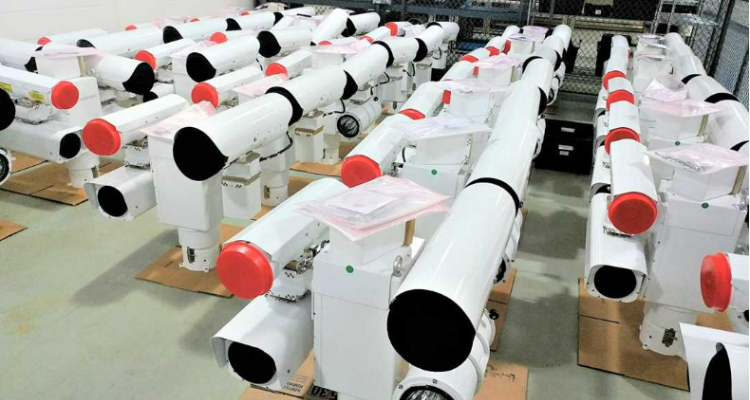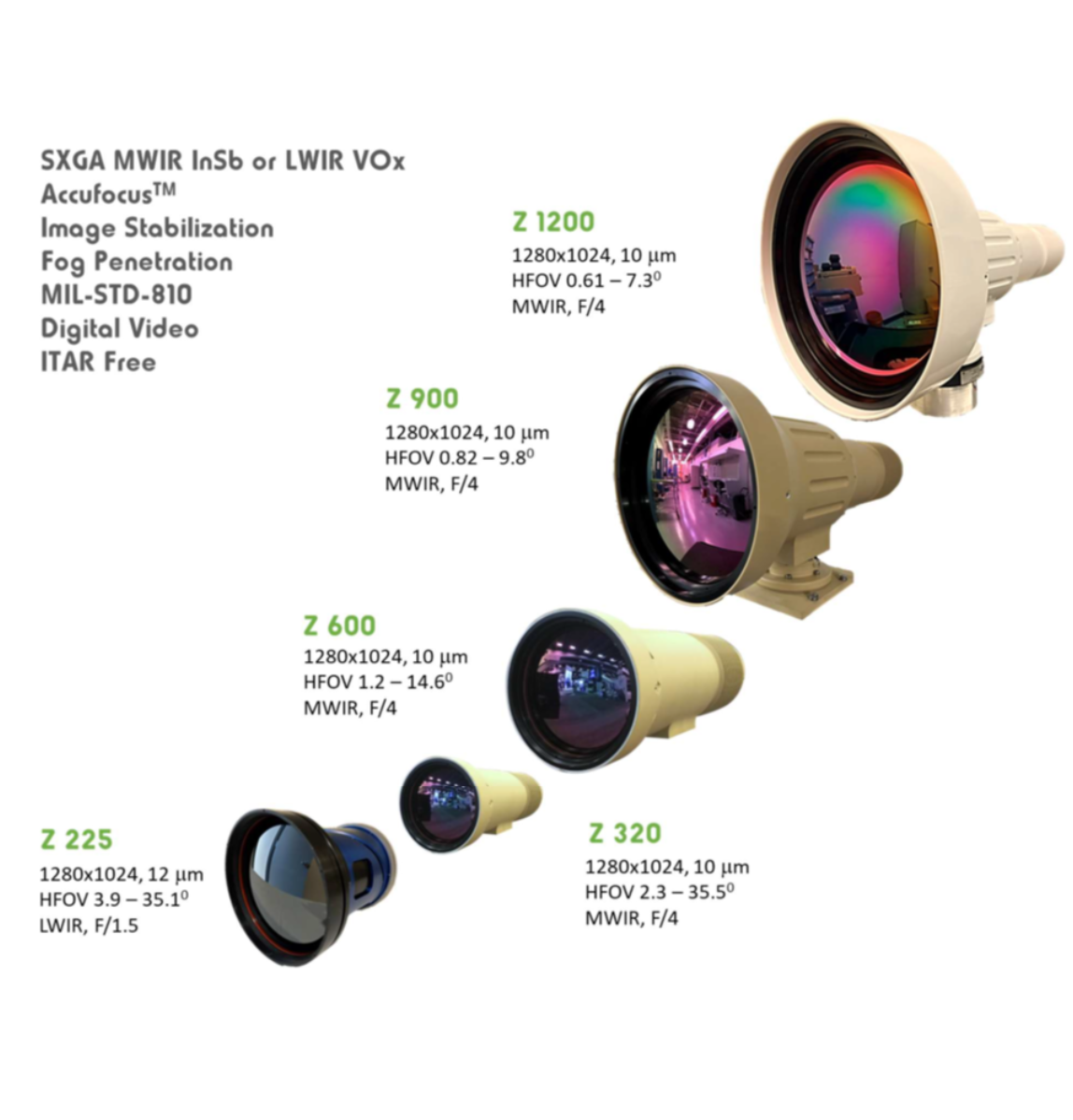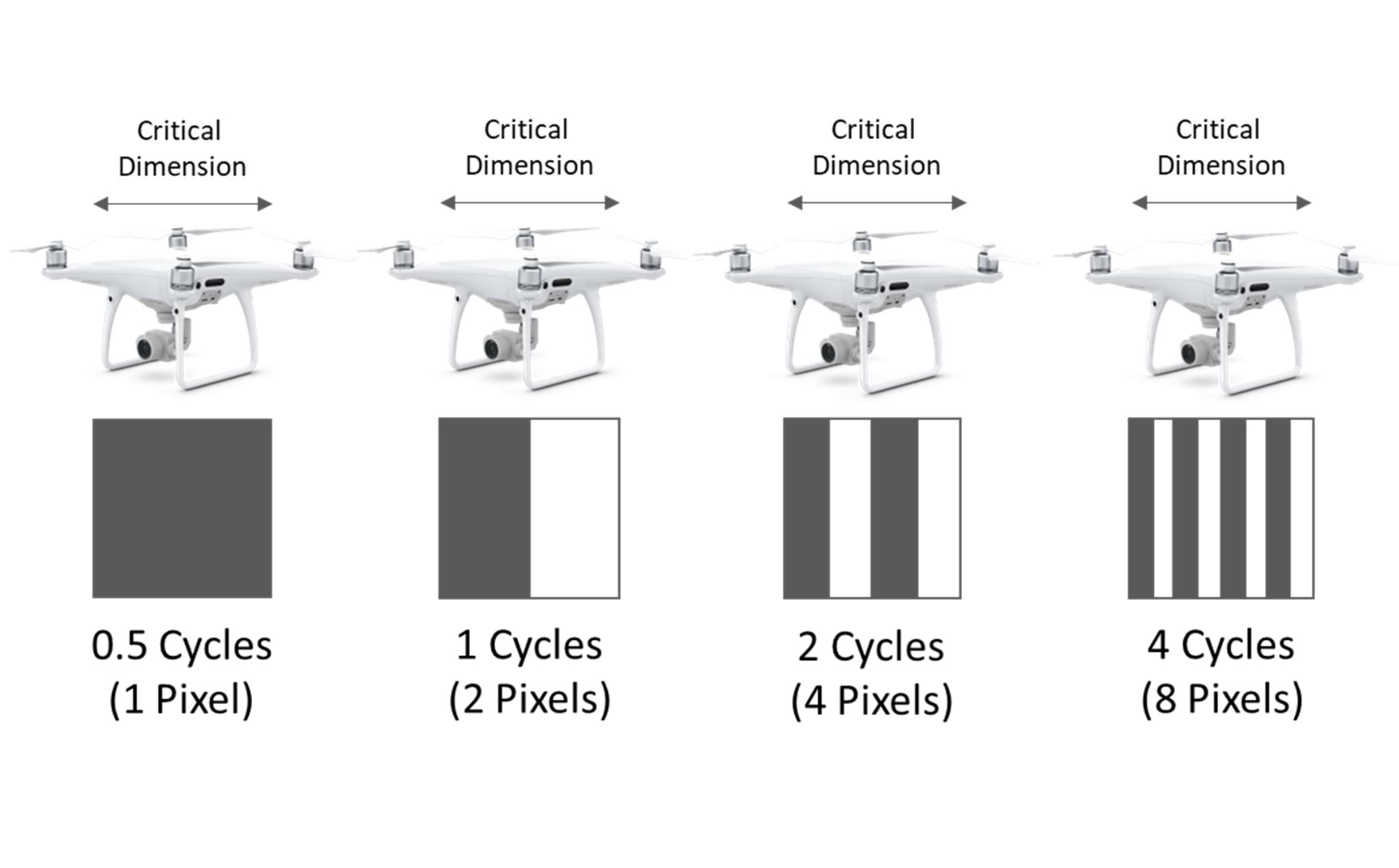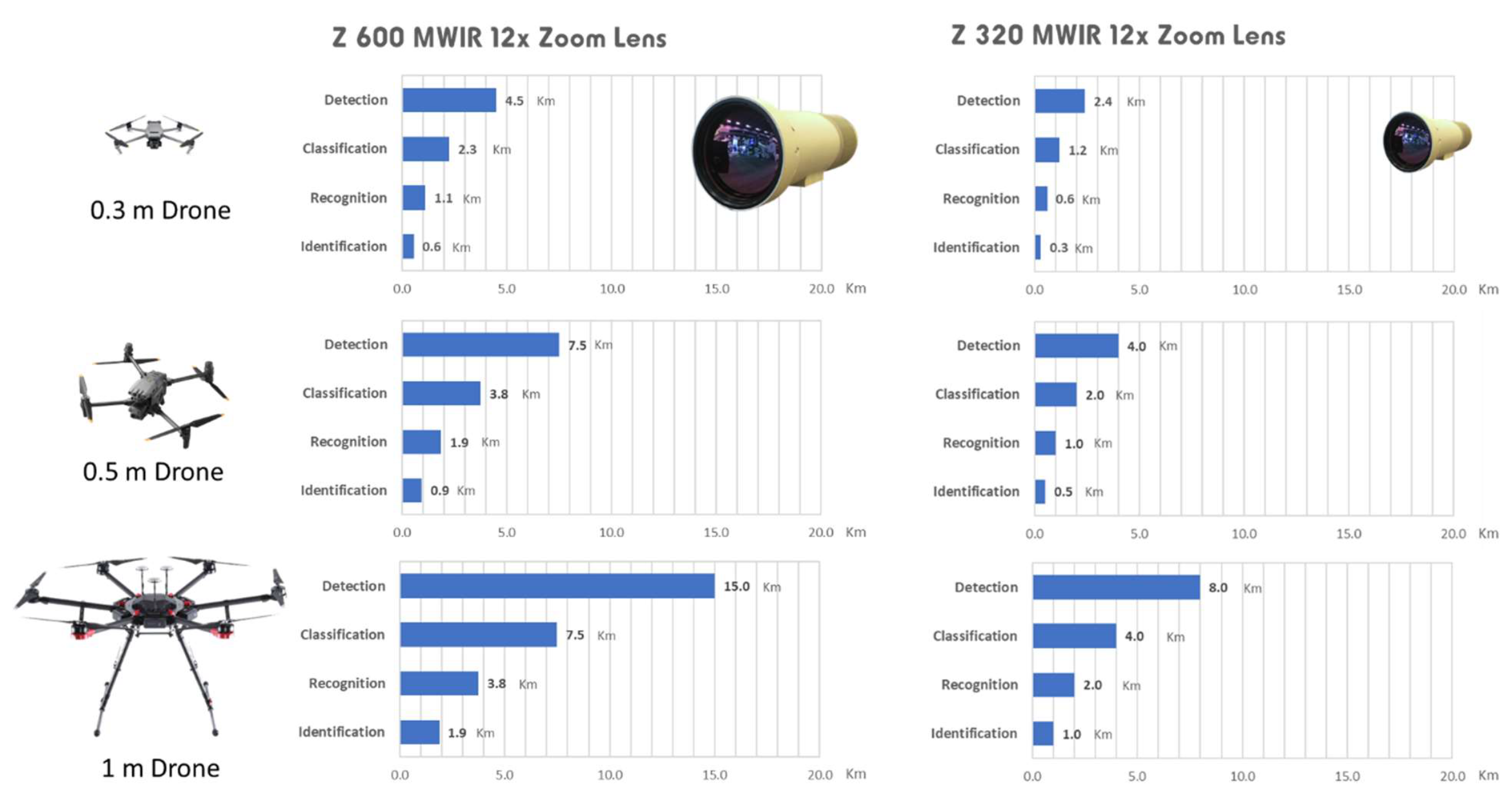Evolving Drone Threats Demand Counter Unmanned Air Systems (C-UAS) with Higher Resolution Imaging for Faster Threat Defeat
- News Article
- Security
- Space

EVOLVING DRONE THREATS DEMAND COUNTER UNMANNED AIR SYSTEMS (C-UAS) WITH HIGHER RESOLUTION IMAGING FOR FASTER THREAT DEFEAT
Unmanned Air Systems (UAS) or drones are an increasingly growing threat to critical infrastructure, airports, and energy generation installations. Malicious use of weaponized drones and drone swarms is ever-present, as is the growing adoption of increasingly smaller, more capable s-UAS drones that require longer range cameras with increased resolution.
Drone technology today enables unmanned air vehicles with ranges of 2-8 km to be flown with an aircraft size of just a few tens of centimeters. Visual identification of a drone threat is necessary, 24/7, under all climatic conditions, and these ultra-small, unmanned aircraft demand ever more capable counter unmanned air systems (C-UAS). Radar and EO/IR sensors must be able to detect a potential threat with sufficient resolution to identify and discriminate between a broader range of small drone variants. Clear Align offers a range of high-definition, mid-wave infrared camera solutions with the highest level of resolution for accurate detection, discrimination and identification of small drones at ranges from several kilometers up to 11 miles. These camera systems match or exceed the performance of radar creating a multi-sensor solution that is fully optimized for C-UAS.
WEAPONIZED DRONES
Group 1 and Group 2 drones are small and inexpensive. They carry increasingly capable COTS sensors and can be modified to carry weaponized payloads, for example guns, explosives or even laser guided bombs1. Low-cost hobbyist drones can be retrofitted with upgraded high-resolution cameras, grenade mechanisms and explosives. Some manufacturers are now offering drones fitted with machine guns, laser rangefinders and advanced sensors to improve accuracy. With 400 m effective range, these mounted machine guns on drones are the next generation of threat.

Figure 1 Examples of weaponized drones 234
Small weaponized drone threats are growing both in terms of abundance and capability driving the need for increasingly capable, counter UAS solutions that combat threats to both our military assets and critical infrastructure.
1 BBC News, 3rd January 2023 “How are ‘kamikaze’ drones being used by Russia and Ukraine?”, www.bbc.co.uk/news/
2 New Scientist “Turkey is getting military drones armed with machine guns”, 12th December 2019
3 Dronedj.com “Weaponized-dji-matrice”, 24th January 2020
4 Wired Magazine “Why the US Government is terrified of hobbyist drones”, 5th February 2015
Photo credit: jbsa.mil/News/Photos/igphoto/2001681871/
DRONE CLASSIFICATION
The US department of defense categorizes drones from small to large, classifying them as group 1 though to 55. Group 5 represents the largest, long-range persistent surveillance drones such as the RQ-4 Global Hawk. Group 1 at the other end of the spectrum, describes small drones (s-UAS) which are less than 20 lbs. in weight and have endurance of a few tens of minutes. Group 1 actually encompasses several sub-classifications of drone including Nano-UAS, Micro-UAS and Small UAS (although it should be noted that these definitions are not universally adopted). The s-UAS are widely available and affordable making them a common threat, either through malicious intent or by inadvertent operation. Some representative s-UAS models are illustrated below along with their approximate size.

Figure 2 Example s-UAV currently available with approximate size6 7 8 9 10
Manufacturer datasheets enable easy calculation of the angle subtended for a given drone based on size and range. The smaller the angular subtense, the higher the camera resolution required to detect the drone. State of the art MWIR sensors have a pixel pitch of 10 m. For a given detection/recognition task we can estimate the required camera focal length to detect each drone at the stated range. Here it can be seen that the nano and micro-UAV variants are the most challenging, requiring focal lengths of approximately 1200 mm.
5 https://www.airdomainintelligence.mil/Global-Air-Hub/Unmanned-Aircraft-System-UAS/UAS-Categories/
6 FLIR Black Hornet Datasheet
7 DJI Phantom 4 Datasheet
8 AeroVironment Raven Datasheet
9 FLIR SkyRanger Datasheet
10 Aeronvironment Puma 3 Datasheet
CLEAR ALIGN'S UNIQUE FAMILY OF INFRARED CAMERAS
Clear Align offers a range of high-definition continuous zoom, thermal imaging cameras operating in the MWIR and LWIR wavebands. These cameras utilize advanced small pitch, cooled and uncooled sensors delivering market leading resolution enabling enhanced levels of details to be discerned at much longer ranges.

Figure 4 Clear Align Range of High Definition Infrared Cameras
These military specification cameras are deployed on the US Border, US Capital Region, and Border and Military Bases around the globe providing 24/7 protection. Working as part of an integrated solution with radar, automatic target recognition (ATR) and RF inhibitors, these cameras are proven and qualified for the most demanding and environmentally challenging applications.
DRONE DETECTION, RECOGNITION & IDENTIFICATION
The ubiquitous Johnson Criteria11 defines detection, recognition, classification, and identification for a target clearly defining the range for a given task. The original work performed on various military targets such as soldiers, howitzers and main battle tanks, specified the number of cycles between 1 and 8 for detection and identification respectively. We can illustrate the meaning of cycles of a drone target in the figure below. A single cycle is a projection of two camera pixels over the target critical dimension. The greater the number of cycles, the higher the resolution and the longer range at which that target can be detected, recognized and identified.

Figure 5 Schematic illustration of cycles over a small drone target
It is clear just by inspection of the above figure, that a greater number of cycles are required to gain sufficient information to determine that the object is a drone rather than an aircraft or bird. Similarly, a greater number of cycles is necessary to discriminate between different drone types.
11 Analysis of image forming systems, J, Johnson, Image Intensifier Symposium, Oct. 1958, Table I
Photo credit Jbsa.mil/News/Photos/igphoto/2002159032/
Drone targets require an increased number of cycles compared to the standard Johnson Criteria to resolve features such as wings or rotors and enable precise positive detection and identification, which in turn necessitates increased camera resolution as illustrated below.

Figure 6 Range Performance (m) for Alternative Lens options as a function of number of cycles across a 0.3 m Micro UAV drone
For classification that the target is a drone, a minimum of 4 cycles are required which can be achieved at ranges of up to 4.5 Km. To recognize what type of basic type of drone you are looking at requires 8 cycles. Using longer focal length cameras including the Clear Align Z 1200, it is possible to discern the type of payload that the drone is carrying which can be achieved at ranges of up to 1 Km. Clearly this increased level of detail is highly beneficial for decision makers and enables faster response to for teams protecting critical infrastructure assets.
To further illustrate the need for increased resolution to discriminate between drone types and payloads, simulations for a fixed wing drone, a Quadcopter and a Hexcopter are shown in Figure 7. Here we can see that 16 cycles across the drone is necessary to have a high degree of confidence to correctly identify the drone type, i.e. is it a fixed wing, or multi-rotor drone. At 32 cycles we can recognize that the drone is carrying a payload and there is sufficient detail to recognize the type of payload that the drone is carrying. Increasing resolution further to 64 cycles gives the ability to identify the payload. In the example shown below the Hexcopter is carrying a small machine gun.

Figure 7 Image Simulations for Recognition and Identification of different drone types and payloads
Using a long focal length camera such as the Clear Align Z 1200 enables identification of the drone payload at a range of 900 m for a 1 m s-UAS.
A comparison of alternative infrared camera solutions for 0.3 m micro-UAS and 1.37m small UAS is illustrated in Figure 8.
For the 1.37 m s-UAS drone, all cameras shown can achieve detection at ranges in excess of 5km. The LWIR Z 225 lens can classify that the target is a drone at 3 km, all MWIR lenses can classify at ranges beyond 5 km for this drone size.
Identification is achieved beyond 5 km using higher resolution 1200 mm MWIR camera. As camera focal length is reduced, identification range diminishes proportionally, so the LWIR, 225 mm camera achieves identification of the s-UAS at 800 m.

Figure 8 Range Performance for 0.3m micro-UAS and 1.37m s-UAS drones using alternative Infrared Cameras
For the 0.3 m micro-UAS drone, identification can be achieved at 1.1km using the MWIR, 1200 mm lens, with recognition achieved at 2.2 km. Classification that the target is a drone can be achieved at 4.5 km, which is in excess of the range of some radar commonly used for C-UAS. This analysis demonstrates the benefit of Clear Align’s longer focal length cameras to achieve sufficient resolution to classify, recognize and identify s-UAS drones and protect critical infrastructure.
INTEGRATED C-UAS SOLUTIONS
For an integrated counter UAS solution, radar provides the situational awareness and early warning detection of potential drone threats. Pulse-doppler radar detect the micro-doppler reflections from the UAS propellers to discriminate between a drone threat and other aircraft or birds. For ground-based installations, typical radar ranges are up to 7.2 km for a micro UAS over a 3600 azimuth field of view. Using the Z 1200 thermal camera, positive visual detection of the same target occurs out to 9 km in the narrow field of view. Radar provides excellent all-weather situational awareness of potential drone threats and MWIR thermal provides visual confirmation of the threat.

Figure 9 Integrated C-UAS solution (excluding inhibitor) showing the range performance of Radar and Long-Range Z 1200 Thermal
The continuous zoom function infrared lens provides the ability to increase the situational awareness of the thermal imager, but at the expense of resolution or range. For the Z 1200 camera, the narrow field of view is 0.610 (blue segment, Figure 9) providing a range of 9 km, the wide field of view has a larger field of view of 7.30 (green segment, Figure 9) but the range reduces to 0.75 km. So the continuous zoom range of 12 x is a great feature for tracking a drone as it moves closer, but the radar paired with the narrow field of view thermal camera is the optimum sensor solution for simultaneous situational awareness and visual identification. Having a thermal camera that meets or exceeds the range of the radar provides simultaneous detection and positive visual identification of the drone threat.
Summary
We analyzed camera resolution for small UAS detection, classification, recognition and identification. The figures below summarize the performance of the Clear Align MWIR continuous zoom camera range for small commercial drones for sizes of 0.3m to 1m.

Figure 10 Detection, Classification, Recognition and Identification ranged for Clear Align Z 1200 and Z 600 MWIR Zoom Lenses

Figure 11 Detection, Classification, Recognition and Identification ranged for Clear Align Z 600 and Z 320 MWIR Zoom Lenses
Note: Range calculations assume a 3 degree target temperature difference, clear air conditions, 1976 US standard atmosphere, target criteria as discussed in Figure 6.
Clear Align provides AI enabled and networked EO/IR systems.
Contact us:
www.ClearAlign.com
info@ClearAlign.com
-
Understanding space: DSEI and UK Space Command
01 Sep 2023 John HillIn March this year, the European Space Agency (ESA) stressed the importance of space as a disruptive force in society and defence in its space strategy report, ‘Revolution Space’. “Countries… that wi ... -
Transforming Defence Programme Performance: a Global Endeavour
31 Jul 2023 Ed RobinsonLooking towards Defence and Security Equipment International 2023 (DSEI), it’s important to explore challenges facing major programme delivery and how a new approach to collaboration and partnering is ... -
Restoring and Increasing Delivery Confidence in Government Major Programme Delivery
13 Jul 2023 Ben Lolley, Jamie Leich, Tony Reeves, Lewis FeilderGovernment Major Programmes and Risk The last nine years has seen Government Major Projects Portfolio (GMPP) spending grow to an astounding £678 billion. Despite significant investments in delivery ca ... -
Reimagining Skills for Space
13 Jul 2023 Jan Morgan, Lewis Feilder, Tony ReevesA comprehensive space education can make Global Britain the world seminary for space Space offers huge prospects for economic growth and solutions on everything from climate change to food security. T ... -
Here’s How the U.S Government Solves Access, Security and Space Problems Simultaneously
21 Jun 2023 Karlene BergerHERE'S HOW THE U.S GOVERNMENT SOLVES ACCESS, SECURITY AND SPACE PROBLEMS SIMULTANEOUSLY Networking and IT professionals face problems with limitations of physical infrastructure. Space. Cabling multip ... -
The Increasing Threat Landscape & the need for Defense-Grade Cybersecurity Solutions
24 May 2023 Joanna CrossleyTHE INCREASING THREAT LANDSCAPE & THE NEED FOR DEFENSE-GRADE CYBERSECURITY SOLUTIONS In today's interconnected world, the threat landscape for cybersecurity is expanding at an alarming rate. Cybercrim ...

)
)
)
)
)
)

